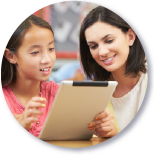Web accessibility means that people with disabilities can perceive, understand, navigate, and interact with the Web, and that they can contribute to the Web.” (W3C, 2005).
The W3C includes the following types of disabilities in its consideration of designing for accessibility: Visual disability,
- Hearing Impairment
- Physical (motor) Disability
- Speech Disability
- Cognitive and Neurological Disability (including learning disability and seizure disorders, for example), multiple disabilities, and aging-related conditions (W3C, 2005).
The Development efforts for accessible Learning Products should focus on these low-incidence disabilities.
The four accessibility features described below comprise the foundation of the Web Content Accessibility Guidelines 2.0 AA. Ideally, a learning product design should include these features to provide a complete experience for students with vision impairments.
- Users can navigate the content using only the keyboard. Users of mobile devices can navigate using the touch screen in screen-reader-mode.
- The content and structure can be understood by a person using a screen reader like NVDA, JAWS, iOS Voiceover, Android Talkback and Chromevox on Chromebooks.
- Text equivalents for all non-text media. This includes captions for video, audio transcripts, and alternative descriptions for images, animations, and videos.
- All visual presentations follow the WCAG 2.0 AA visual guidelines.
Here are some examples of accessible content created by Magic Software:
Color Contrast
Drag and Drop, Access Keys
Access Keys, Closed Captioning
Video Captioning





